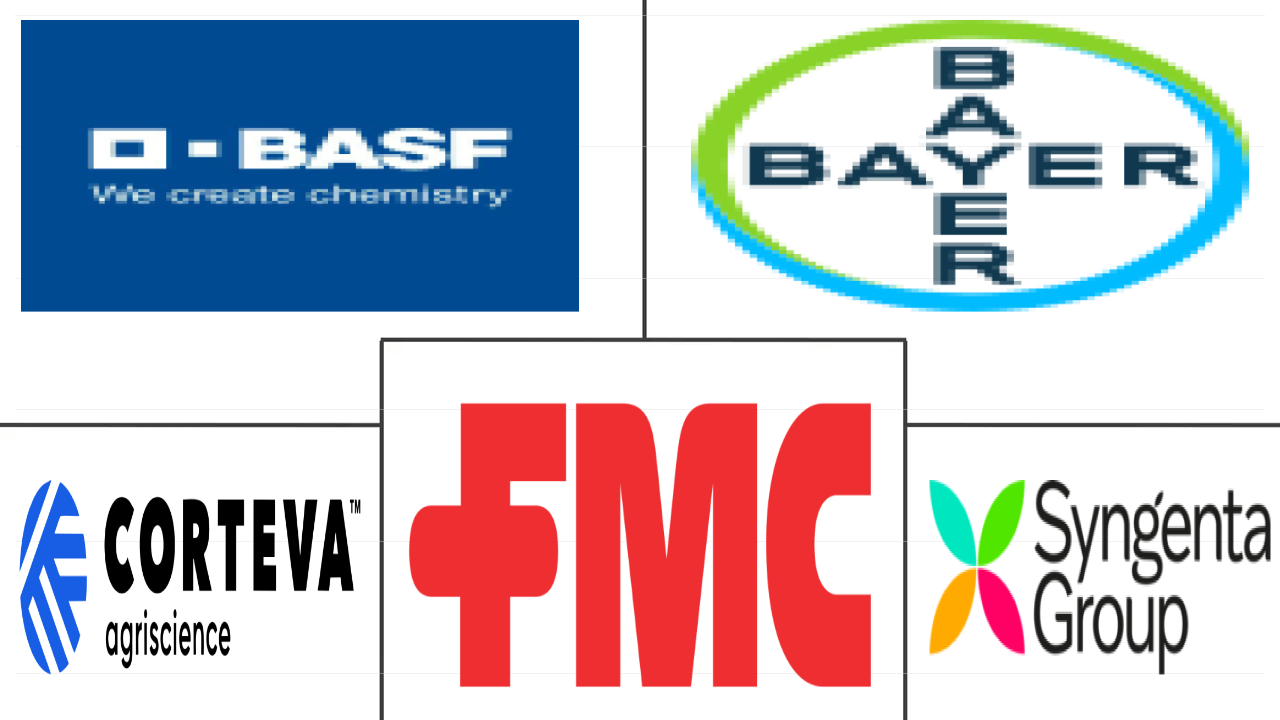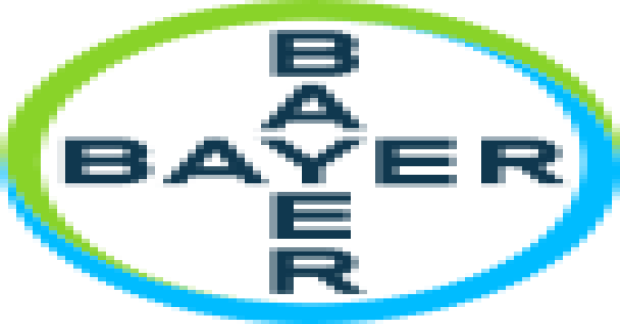Market Size of brazil crop protection chemicals Industry
| Icons | Lable | Value |
|---|---|---|
|
|
Study Period | 2017 - 2029 |
|
|
Market Size (2024) | USD 19.2 Billion |
|
|
Market Size (2029) | USD 24.2 Billion |
|
|
Largest Share by Function | Herbicide |
|
|
CAGR (2024 - 2029) | 4.73 % |
|
|
Fastest Growing by Function | Molluscicide |
|
|
Market Concentration | Medium |
Major Players |
||

|
||
|
*Disclaimer: Major Players sorted in no particular order |
Brazil Crop Protection Chemicals Market Analysis
The Brazil Crop Protection Chemicals Market size is estimated at 19.2 billion USD in 2024, and is expected to reach 24.2 billion USD by 2029, growing at a CAGR of 4.73% during the forecast period (2024-2029).
19.2 Billion
Market Size in 2024 (USD)
24.2 Billion
Market Size in 2029 (USD)
7.28 %
CAGR (2017-2023)
4.73 %
CAGR (2024-2029)
Largest Segment By Function
40.82 %
value share, Herbicide, 2023
The market for herbicides in Brazil witnessed a positive trend between 2017-2022, due to the increasing weed infestations and subsequent yield losses in the country.
Fastest-growing Segment by Function
8.52 %
Projected CAGR, Molluscicide, 2024-2029
The giant African snail and golden apple snail are invasive species with voracious appetites and the ability to reproduce rapidly, posing a serious threat to various crops, tends to increased market share.
Largest Segment by Crop Type
49.62 %
value share, Pulses & Oilseeds, 2023
Soybean, a pulse and oilseed crop, comprised more than a third of the sector's production value in Brazil in 2021. It is prone to Asian soybean rust and southern armyworm.
Leading Market Player
11.59 %
market share, Syngenta Group, 2022

The company invests more than USD 1.3 billion per year in global R&D to develop advanced, innovative technologies and products to address farmers' crop protection challenges.
Second Leading Market Player
11.51 %
market share, Bayer AG, 2022

Bayer AG has important production units of agribusiness in Brazil located in the Baixada Fluminense region of Rio de Janeiro, the company's first production plant in Brazil.
Insecticides occupy the largest share of the Brazilian crop protection chemicals market
- Insect pests, diseases, and weeds are emerging as significant problems in Brazil's agriculture sector. To counter these threats effectively, farmers predominantly depend on pesticides as the primary defense against these pests. Herbicides held the largest share of 40.6% of the Brazilian crop protection chemicals market in 2022.
- The market for herbicides in Brazil witnessed a positive trend during the historical period (2017-2022), which rose to USD 7.18 billion in 2022. The prevalence of resistant weeds in certain areas, coupled with estimated production losses of 10-20% due to crop-weed competition, results in annual losses exceeding USD 1.0 billion for each crop
- Pulses & oilseeds dominate the consumption of crop protection chemicals in Brazil, with a share of 49.5% in 2022. Soybean cultivation in Brazil faces numerous pest challenges, with lepidopterans and stink bugs being the primary pests requiring special attention. Particularly, the southern armyworm is known to inflict a significant 17.0% yield loss on soybean production.
- Soybean production in the Southern Amazon region is at risk from the Phakopsora pachyrhizi fungus, recognized as Asian soybean rust. This pathogen induces staggering yield reductions, with estimates reaching as high as 90%. Since its initial outbreak in 2000, it has consistently led to annual yield diminutions ranging between 360,000 and 4.6 million ton. Additionally, the nematode's impact on soybean cultivars varies based on the region and genetic background, resulting in yield losses as high as 30%.
- The need to increase crop yields in Brazil is anticipated to drive the market for pesticides during 2023-2029 at a CAGR of 4.7%, in terms of value.
Brazil Crop Protection Chemicals Industry Segmentation
Fungicide, Herbicide, Insecticide, Molluscicide, Nematicide are covered as segments by Function. Chemigation, Foliar, Fumigation, Seed Treatment, Soil Treatment are covered as segments by Application Mode. Commercial Crops, Fruits & Vegetables, Grains & Cereals, Pulses & Oilseeds, Turf & Ornamental are covered as segments by Crop Type.
- Insect pests, diseases, and weeds are emerging as significant problems in Brazil's agriculture sector. To counter these threats effectively, farmers predominantly depend on pesticides as the primary defense against these pests. Herbicides held the largest share of 40.6% of the Brazilian crop protection chemicals market in 2022.
- The market for herbicides in Brazil witnessed a positive trend during the historical period (2017-2022), which rose to USD 7.18 billion in 2022. The prevalence of resistant weeds in certain areas, coupled with estimated production losses of 10-20% due to crop-weed competition, results in annual losses exceeding USD 1.0 billion for each crop
- Pulses & oilseeds dominate the consumption of crop protection chemicals in Brazil, with a share of 49.5% in 2022. Soybean cultivation in Brazil faces numerous pest challenges, with lepidopterans and stink bugs being the primary pests requiring special attention. Particularly, the southern armyworm is known to inflict a significant 17.0% yield loss on soybean production.
- Soybean production in the Southern Amazon region is at risk from the Phakopsora pachyrhizi fungus, recognized as Asian soybean rust. This pathogen induces staggering yield reductions, with estimates reaching as high as 90%. Since its initial outbreak in 2000, it has consistently led to annual yield diminutions ranging between 360,000 and 4.6 million ton. Additionally, the nematode's impact on soybean cultivars varies based on the region and genetic background, resulting in yield losses as high as 30%.
- The need to increase crop yields in Brazil is anticipated to drive the market for pesticides during 2023-2029 at a CAGR of 4.7%, in terms of value.
| Function | |
| Fungicide | |
| Herbicide | |
| Insecticide | |
| Molluscicide | |
| Nematicide |
| Application Mode | |
| Chemigation | |
| Foliar | |
| Fumigation | |
| Seed Treatment | |
| Soil Treatment |
| Crop Type | |
| Commercial Crops | |
| Fruits & Vegetables | |
| Grains & Cereals | |
| Pulses & Oilseeds | |
| Turf & Ornamental |
Brazil Crop Protection Chemicals Market Size Summary
The Brazil Crop Protection Chemicals Market is experiencing a robust expansion, driven by the increasing need to combat insect pests, diseases, and weeds that pose significant challenges to the agricultural sector. Farmers in Brazil predominantly rely on pesticides, with herbicides holding a substantial portion of the market share. The demand for crop protection chemicals is further fueled by the prevalence of resistant weeds and the substantial production losses attributed to crop-weed competition. Pulses and oilseeds, particularly soybean cultivation, dominate the consumption of these chemicals, as they face numerous pest challenges, including lepidopterans and stink bugs. The impact of pathogens like the Phakopsora pachyrhizi fungus and nematodes also contributes to the pressing need for effective crop protection solutions to mitigate yield losses.
The market is characterized by a significant reliance on imported agrochemical products, with the European Union being a major supplier. This dependency on imports subjects the market to fluctuations influenced by currency exchange rates and import tariffs. The prices of key active ingredients such as cypermethrin, atrazine, glyphosate, malathion, and mancozeb are witnessing upward trends due to rising demand and increased production costs. The market is moderately consolidated, with major players like BASF SE, Bayer AG, Corteva Agriscience, FMC Corporation, and Syngenta Group holding significant shares. Recent developments, such as new partnerships and facility openings, indicate ongoing efforts to innovate and enhance crop protection solutions in Brazil, addressing both current challenges and future market demands.
Brazil Crop Protection Chemicals Market Size - Table of Contents
-
1. MARKET SEGMENTATION (includes market size in Value in USD and Volume, Forecasts up to 2029 and analysis of growth prospects)
-
1.1 Function
-
1.1.1 Fungicide
-
1.1.2 Herbicide
-
1.1.3 Insecticide
-
1.1.4 Molluscicide
-
1.1.5 Nematicide
-
-
1.2 Application Mode
-
1.2.1 Chemigation
-
1.2.2 Foliar
-
1.2.3 Fumigation
-
1.2.4 Seed Treatment
-
1.2.5 Soil Treatment
-
-
1.3 Crop Type
-
1.3.1 Commercial Crops
-
1.3.2 Fruits & Vegetables
-
1.3.3 Grains & Cereals
-
1.3.4 Pulses & Oilseeds
-
1.3.5 Turf & Ornamental
-
-
Brazil Crop Protection Chemicals Market Size FAQs
How big is the Brazil Crop Protection Chemicals Market?
The Brazil Crop Protection Chemicals Market size is expected to reach USD 19.20 billion in 2024 and grow at a CAGR of 4.73% to reach USD 24.20 billion by 2029.
What is the current Brazil Crop Protection Chemicals Market size?
In 2024, the Brazil Crop Protection Chemicals Market size is expected to reach USD 19.20 billion.

